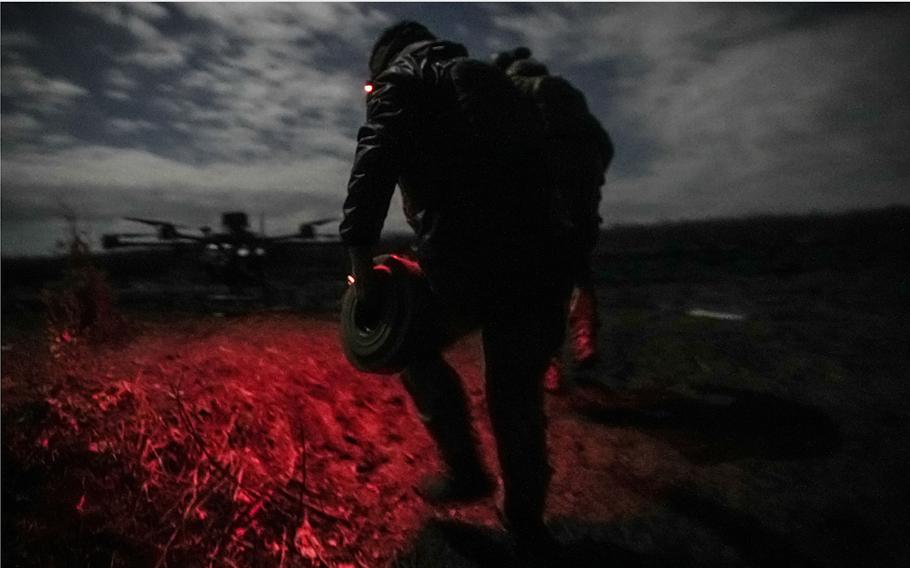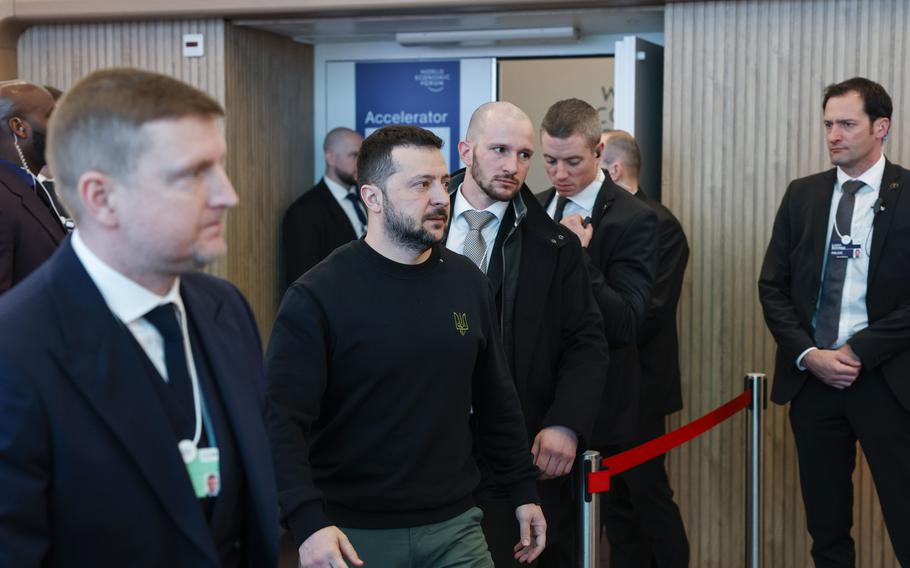Europe
Zelenskyy in bind over how to draft more troops as Russian forces advance
The Washington Post March 4, 2024

Ukrainian forces operate during a Vampire drones night mission on the front line in Ukraine on Oct. 28, 2023. (Julia Kochetova/Bloomberg)
KYIV — Even as he promises international partners that Ukraine will handle the fighting if given needed weapons and other support, President Volodymyr Zelenskyy and his top military commanders have failed so far to come up with a clear plan to conscript or recruit many thousands of new soldiers critically needed to defend against Russia’s continuing attacks.
Zelenskyy’s inability to forge a political consensus on a mobilization strategy — despite months of warnings about a severe shortage of qualified troops on the front — has fueled deep divisions in Ukraine’s parliament and more broadly in Ukrainian society. It has left the military relying on a hodgepodge of recruiting efforts and sown panic among fighting-age men, some of whom have gone into hiding, worried that they will be drafted into an ill-equipped army and sent to certain death given that aid for Ukraine remains stalled in Washington.
The quandary over how to fill the ranks has confronted Zelenskyy with perhaps the greatest challenge to his leadership since the start of the February 2022 invasion. The lack of a clear mobilization strategy — or even agreement on how many more troops Ukraine needs — factored into Zelenskyy’s dismissal of his top general in February, but the new commander in chief, Oleksandr Syrsky, so far has brought no new clarity.
Syrsky has been tasked with auditing the existing armed forces to find more combat-eligible troops, after Zelenskyy’s office recently announced that of the 1 million people who have been mobilized, only about 300,000 have fought at the front lines. But nearly a month after his promotion, no one in the military leadership or the presidential administration has explained where those 700,000 are — or what they have been doing.
Ukrainian lawmakers say the lack of a unified message from the president and the military has added confusion over next steps.
“I don’t know why Zelenskyy or his team still try to convince society that everything is always fine,” said Solomiia Bobrovska, a lawmaker from Holos, a liberal opposition party. “It’s not — especially with the army.”
Ukraine’s dwindling number of battle-ready troops is now a strategic crisis that was at least partially to blame for its recent retreat from the eastern city of Avdiivka and surrounding villages, where Ukrainian forces were far outnumbered.
Oleksiy Bezhevets, an adviser to the Defense Ministry on recruitment, said civilians of fighting age must accept that “there’s no time for you left to sit home.”
“It’s quite possible Russians will move much closer quite soon if there’s nobody to stop them,” Bezhevets said. If, in addition to “the lack of ammunition, weapons, shells and so on, we’ve got a lack of personnel, it’s a tragedy,” he added.
But after two years of all-out war, the sense of public urgency that spurred new troops to the battlefield and fueled Ukraine’s early successes has faded. Many soldiers are wounded or exhausted.
For all this time, men between the ages of 18 and 60 have been banned from leaving the country, and men 27 and older have been eligible to be drafted, with some exceptions. Civilians between 18 and 27 can sign up on their own. Parliament has now spent months heatedly debating a bill that would change the mobilization process and widen the scope of the draft, in part by lowering the eligibility age to 25.

Volodymyr Zelenskyy, Ukraine’s president, center, is escorted by security from a bilateral meeting on the opening day of the World Economic Forum (WEF) in Davos, Switzerland, on Tuesday, Jan. 16, 2024. (Stefan Wermuth/Bloomberg)
More than 4,000 amendments have been made to the mobilization bill, and some lawmakers see the measure as an attempt by Zelenskyy to pass off responsibility to parliament for inevitably unpopular decisions.
“It’s time to start an adult conversation with society and not to be afraid of it, ” Bobrovska said. “It’s not 2022, when emotions took over.”
Zelenskyy has long tried to control public messaging about the state of the war to preserve public morale. He publicly announced a death toll for Ukrainian troops for the first time last weekend, saying that 31,000 have been killed since February 2022 — a number that could not be independently confirmed.
Zelenskyy is also facing mounting pessimism at home and abroad about Ukraine’s chances of holding off the Russian onslaught without more help from the United States. House Speaker Mike Johnson (R-La.) has refused to take up legislation that includes some $60 billion in aid for Ukraine.
“It’s time for serious talks with society — serious and honest talks and to explain what we have to do without any artificial bravery,” said Volodymyr Aryev, a lawmaker from the opposition European Solidarity party.
Bobrovska is backing proposed changes to the bill that would ensure the demobilization of troops who have already served lengthy stints in front-line positions. As it stands, she said, “the only way to be back is injured or killed.”
“War is math,” she added. “We have to count our resources.”
Aryev voted against an earlier draft of the mobilization bill that he deemed too punitive. He opposes measures like suspending driver’s licenses and seizing bank assets of citizens who do not register for the draft. In January, fearing such measures, account holders rushed to withdraw their money, taking out more than $700 million in a single month — the most withdrawn since February 2022.
The priority, Aryev said, should be to “guarantee to people who will be mobilized for military service that … they will not be sent to the front line without trainings and without proper equipment. It’s really scaring people and creates a lack of trust [in] the government.”
Those fears are driving some draft-eligible men to take evasive steps.
One 31-year-old man, whose parents are living under Russian occupation in eastern Ukraine, said he is hiding in an apartment in Kyiv, fearful that he will be drafted and sent to the front unprepared and ill-equipped. He spoke on the condition of anonymity because of concerns for his safety.
In December, while visiting the central Ukrainian city of Vinnytsia, soldiers stopped him on the street and handed him a draft notice. He left without visiting the recruitment office there, hoping his case would disappear into a disorganized bureaucratic system.
But a month later, police in Kyiv stopped him for a random check. When they searched his name in their database, he saw the word WANTED pop up in big red letters. Officials in Vinnytsia had registered his failure to appear.
He was ordered to appear at a recruitment office the next morning, but had a panic attack and did not go. He has no military experience. “You cannot imagine a person who is further from the army or military stuff,” he said. “It just doesn’t really make sense to me to hunt me like that.”
In November, the Defense Ministry partnered with Lobby X, a recruiting platform that posts job openings in the military, ranging from front-line roles to rear-end logistics or IT.
“People first of all want to control their future as much as possible and want to have clarity about what they will do in the army,” said Vladyslav Greziev, co-founder of Lobby X. While applications have soared for less risky posts, “the challenge is to fill the combat positions,” Greziev said.
The 31-year-old in hiding said he considered applying for a noncombat role but fears that once enrolled, he could be transferred to combat duty. For now, he plans to stay inside indefinitely until a lawyer can help resolve his case. “It’s still better than going there and dying in a week, which is my maximum, I think,” he said.
Yaroslav Yurchyshyn, a member of parliament from the Holos party, said lawmakers are seeking an “appropriate motivation mechanism” to encourage enlistment, including bonuses for destroying Russian equipment and new financial benefits for veterans.
“It’s a hard discussion because previously we mobilized people who have this feeling of duty,” Yurchyshyn said. “Now we must motivate our people to serve in the army.”
Bezhevets, the adviser to the Defense Ministry, said, “The country has a future up to the moment where there are people who are ready to fight for it and to die for it.”
“I don’t like ‘to die for it’ — it’s better to kill for it,” he added. But despite the existential threat to Ukraine, many civilians, he said, are “just dust in the wind.”
Kostiantyn Khudov and Serhiy Morgunov in Kyiv contributed to this report.